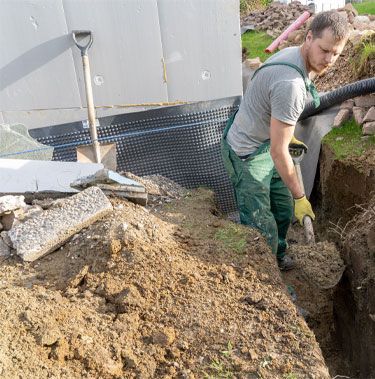Discover Cost Effective and Durable Options for Your French Drain System Needs
Comprehending the Value of a Septic Container French Drain for Effective Wastewater Monitoring
The integration of a septic storage tank French drainpipe system plays a critical role in efficient wastewater administration, yet its value is typically forgotten. Understanding the mechanics and benefits of such a system can brighten its important duty in preventing soil saturation and enhancing groundwater top quality.
What Is a Sewage-disposal Tank French Drain?
A septic storage tank French drainpipe is a specific drain system designed to take care of wastewater and avoid flooding in locations where traditional drain methods may be inadequate. This system integrates the functionalities of a standard septic system with a French drainpipe, permitting effective wastewater therapy and effective water diversion.

Built utilizing perforated pipes stocked crushed rock trenches, a French drain helps with the movement of water far from vital locations. It permits for the infiltration of excess water into the surrounding soil, promoting reliable drainage while shielding the septic tank's stability. The mix of these 2 systems is specifically valuable in areas with hefty rainfall or inadequate water drainage, ensuring the long life and performance of wastewater administration systems while protecting public wellness and the setting.

Just How It Functions in Wastewater Monitoring
In wastewater monitoring, the combination of a septic system and French drain plays an important function in guaranteeing efficient treatment and disposal of sewer. The septic system functions as the first line of protection, where wastewater goes through preliminary treatment via sedimentation and anaerobic digestion. Solids clear up near the bottom, forming sludge, while lighter materials, such as oil and oils, float to the top, developing a scum layer. This procedure minimizes the organic load of the wastewater prior to it relocates forward.
As soon as the wastewater is made clear, it moves into the French drainpipe system, which is developed to help with further therapy and risk-free dispersal. The French drain is composed of perforated pipelines buried in gravel or rock, permitting treated effluent to percolate right into the bordering soil. This natural filtering procedure help in the removal of nutrients and pathogens, promoting groundwater recharge and lowering the risk of surface contamination.
With each other, the sewage-disposal tank and French drain create a lasting approach to wastewater management, reducing ecological effect while guaranteeing conformity with wellness guidelines. This integrated system not only secures public wellness but also maintains the honesty of local environments.
Benefits of a French Drainpipe System

The French drainpipe system offers numerous benefits that enhance both wastewater monitoring and ecological defense. Largely, it successfully redirects water away from vital locations, lowering the risk of flooding and soil saturation that can endanger septic systems. This positive drainage service helps preserve the honesty of the sewage-disposal tank by stopping excess wetness, which can lead to system failure.
Additionally, a properly installed French drainpipe reduces the potential for groundwater contamination. By directing wastewater away from the residential or commercial property, it minimizes the likelihood of contaminants going into local water resources, therefore securing public wellness and maintaining environmental equilibrium. The system additionally improves the appearances and capability of exterior spaces by protecting against water buildup, which can produce unpleasant puddles or sloppy locations.
Furthermore, French drains call for reasonably low maintenance compared to various other drain remedies, making them a cost-effective lasting financial investment. Their adaptability enables them to be utilized in different landscapes, suiting both domestic and business residential or commercial properties. Inevitably, the benefits of a French drainpipe system expand past immediate drain demands, contributing to lasting wastewater management methods and advertising ecological stewardship.
Typical Concerns Without a French Drainpipe
Overlooking the setup of a French drainpipe can result in significant difficulties in managing water flow and keeping soil integrity. One of the key concerns is the buildup of excess surface area water, which can produce pooling or flooding in lawns, specifically after hefty rainfall. This torpidity can fill the dirt, bring about erosion and endangering the foundation of nearby frameworks.
In addition, without a French drainpipe, groundwater can poorly infiltrate septic tanks, boosting the threat of system failure. The resulting backup can lead to undesirable odors, health and wellness wikipedia reference risks, and costly fixings. Poor water drainage can likewise advertise the growth of mold and mold, which can adversely affect indoor air high quality and position wellness risks to passengers.
Ultimately, the lack of a French drainpipe can result in a variety of ecological and structural concerns that require significant intervention and cost to remedy. Implementing a French drain system is crucial for reliable wastewater administration and building defense.
Upkeep Tips for Homeowners
Regular upkeep of a French drainpipe is vital to ensure its optimal efficiency and durability. If debris is present, consider making use of a high-pressure water jet to clear the drainpipe.
Additionally, it is crucial to keep the area around the French drain without debris, such as leaves, soil, and various other organic issue. This will avoid blocking and permit effective water drainage. Consistently cutting plants and growing away from the drainpipe can also minimize root invasion.
Moreover, homeowners ought to keep track of the efficiency of their French drain after heavy rainfall. More about the author Observing how well water is guided away from the septic system can offer insights into its capability. If pooling water is noted, it may suggest a demand for expert evaluation.
Last but not least, take into consideration organizing regular expert assessments to evaluate the general problem of the drain. Such positive measures will help keep the performance of your French drainpipe and make certain efficient wastewater monitoring for years ahead.
Verdict
In verdict, the septic storage tank French drain system plays an important duty in reliable wastewater management by making certain appropriate therapy of sewer and effective water diversion. Generally, the septic container French drain represents a sustainable option that profits both household and business buildings throughout numerous landscapes.
The assimilation of a septic storage tank French drain system plays a critical function in efficient wastewater monitoring, yet its significance is frequently neglected. Inevitably, the benefits of a French drain system expand beyond immediate drain needs, contributing to lasting wastewater management practices and promoting environmental stewardship.
Additionally, without a French drainpipe, groundwater can improperly infiltrate septic systems, increasing the threat of system failure - French Drain System. Carrying out a French drainpipe system is vital for efficient wastewater monitoring and residential property security
In verdict, the septic tank French drainpipe system plays an Read Full Article important role in effective wastewater monitoring by making sure proper therapy of sewage and reliable water diversion.